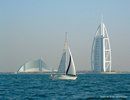Oyster 26
Sailboat specifications
The Oyster 26 is a 26’2” (7.98m) cruising sailboat designed by Holman & Pye (United Kingdom). She was built between 1978 and 1981 by Oyster (United Kingdom) with 47 hulls completed.
Oyster 26's main features
- Model
- Oyster 26
- Hull type
- Monohull
- Category
- Cruising sailboat
- Sailboat builder
- Sailboat designer
- Country
- United Kingdom
- Construction
- Hull and deck: GRP (glass reinforced polyester)
- Number of hulls built
- 47
- First built hull
- 1978
- Last built hull
- 1981
- Appendages
- Keel : fin without bulb
- Helm
- Single tiller
- Rudder
- Single transom hung rudder
- Unsinkable
- No
- Trailerable
- No
- Standard public price ex. VAT (indicative only)
- N/A €
Oyster 26's main dimensions
- Hull length
- 26’ 2”7.98 m
- Waterline length
- 22’ 8”6.93 m
- Beam (width)
- 9’ 10”3 m
- Draft
- 4’ 10”1.45 m
- Light displacement (MLC)
- 6360 lb2885 kg
- Ballast weight
- 2535 lb1150 kg
Oyster 26's rig and sails
- Upwind sail area
- 409 ft²38 m²
- Rigging type
- Sloop Marconi 3/4
- Mast configuration
- Deck stepped mast
- Rotating spars
- No
- Number of levels of spreaders
- 1
- Spreaders angle
- Swept-back
- Spars construction
- Aluminum spars
- Standing rigging
- 1x19 strand wire continuous
Oyster 26's performances
- Upwind sail area to displacementiThe ratio sail area to displacement is obtained by dividing the sail area by the boat's displaced volume to the power two-thirds.
The ratio sail area to displacement can be used to compare the relative sail plan of different sailboats no matter what their size.
Upwind: under 18 the ratio indicates a cruise oriented sailboat with limited performances especially in light wind, while over 25 it indicates a fast sailboat. - 202 ft²/T18.75 m²/T
- Displacement-length ratio (DLR)iThe Displacement Length Ratio (DLR) is a figure that points out the boat's weight compared to its waterline length. The DLR is obtained by dividing the boat's displacement in tons by the cube of one one-hundredth of the waterline length (in feet).
The DLR can be used to compare the relative mass of different sailboats no matter what their length:
a DLR less than 180 is indicative of a really light sailboat (race boat made for planning), while a DLR greater than 300 is indicative of a heavy cruising sailboat. - 245
- Ballast ratioiThe Ballast ratio is an indicator of stability; it is obtained by dividing the boat's displacement by the mass of the ballast. Since the stability depends also of the hull shapes and the position of the center of gravity, only the boats with similar ballast arrangements and hull shapes should be compared.
The higher the ballast ratio is, the greater is the stability. - 40 %
- Critical hull speediAs a ship moves in the water, it creates standing waves that oppose its movement. This effect increases dramatically the resistance when the boat reaches a speed-length ratio (speed-length ratio is the ratio between the speed in knots and the square root of the waterline length in feet) of about 1.2 (corresponding to a Froude Number of 0.35) . This very sharp rise in resistance, between speed-length ratio of 1.2 to 1.5, is insurmountable for heavy sailboats and so becomes an apparent barrier. This leads to the concept of "hull speed".
The hull speed is obtained by multiplying the square root of the waterline length (in feet) by 1.34. - 6.39 knots
Oyster 26's auxiliary engine
- Engine(s)
- 1 inboard engine
- Engine(s) power
- 8 HP
- Fuel type
- Diesel
- Fuel tank capacity
- 10.6 gal40 liters
Oyster 26's accommodations and layout
- Cockpit
- Closed aft cockpit
- Cabin(s)
- 1
- Berth(s) (min./max.)
- 4 / 6
- Freshwater tank capacity
- 30.4 gal115 liters
Similar sailboats that may interest you:
Sailboats
First built hull
Hull length
1969
25’7.62 m
1983
27’ 7”8.4 m
1977
26’ 2”8 m
1971
30’9.14 m
1984
27’ 1”8.25 m
1969
28’ 11”8.8 m
1979
26’7.93 m
1982
24’ 7”7.5 m
1969
25’ 11”7.9 m
1975
27’ 7”8.4 m
1983
30’ 2”9.2 m
1982
25’ 4”7.7 m
1989
25’ 4”7.7 m
1977
27’8.23 m
1977
23’ 7”7.2 m





